Lithuania's housing market remains buoyant
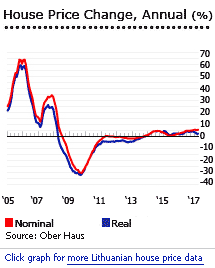 House prices continue to rise in Lithuania, amidst modest economic growth. Property demand is rising strongly, and residential construction is surging. Apartment prices in the capital, Vilnius, have risen by 24.4% (11.2% inflation-adjusted) since the post-crisis low of May 2010, in a slow and steady rise.
House prices continue to rise in Lithuania, amidst modest economic growth. Property demand is rising strongly, and residential construction is surging. Apartment prices in the capital, Vilnius, have risen by 24.4% (11.2% inflation-adjusted) since the post-crisis low of May 2010, in a slow and steady rise.
Lithuania’s five major cities’ apartment price index (covering Vilnius, Kaunas, Klaipėda, Šiauliai and Panevėžys) rose by 5.56% during the year to Q1 2017(2.38% inflation-adjusted), according to OberHaus Real Estate Advisors.
All of Lithuania’s major cities saw moderate house price rises during the year to end-Q1 2017:
- In Vilnius average apartment prices rose by 6.8% y-o-y in Q1 2017, to €1,435 per square metre (sq. m.).
- In Kaunas, apartment prices rose by 4.5%, to €993 per sq. m.
- In Klaipėda, apartment prices increased 2.9%, to an average of €1,019 per sq. m
- In Šiauliai, apartment prices increased 5.2%, to an average of €601 per sq. m.
- In Panevėžys, existing flats rose by 4.7%, to an average of €562 per sq. m.
In 2016, the number of apartment sales in Vilnius increased 13% to about 11,000 units from a year earlier – exceeding the sales seen in 2007 by 2%, according to OberHaus. In the primary market, more than 4,300 apartments were sold last year, up 33% from 2015.
Property demand strong
Property demand is now rising strongly. Apartments purchase-sale transactions in the country rose by 13% y-o-y in 2016, based on figures from State Enterprise Centre of Registers. For private homes, purchase-sale transactions increased 7% over the same period.
In major Lithuanian cities:
- In Vilnius, apartment purchase-sale transactions rose by 13% y-o-y in 2016 while house sales fell by 9%. Land transactions in the city increased 16% over the same period.
- In Kaunas, transactions for apartments and houses increased by both 10% y-o-y in 2016.
- In Klaipėda, apartment transactions rose by 10% while house sales fell by 5%.
- In Šiauliai, apartment sales rose by 9% and house sales soared 28% over the same period.
- In Panevėžys, apartment sales increased slightly by 1% while house sales surged by 34%.
Due to the strong demand, there are fewer unsold newbuild apartments in the market. In 2016, there were about 1,020 unsold newly built apartments in Vilnius, almost 30% down from the previous year.
Residential construction is surging. New dwellingbuilding permitgrants rose by 22.3% y-o-y in 2016, while completions surged by 24.8%, according to Statistics Lithuania.
“The main reasons for market activity and price growth [are] growing income of the population, particularly low loan interest rates and continuing interest in housing as an investment,” said OberHaus on its recent report.
Almost all Lithuanian dwelling stock (98%) is in private ownership.
There are virtually no restrictions in foreign ownership of land in Lithuania, except for agricultural lands.
Lithuania’s economy grew by 2.2% in 2016, after expanding by 1.8% in 2015, 3% in 2014, 3.3% in 2013, 3.8% in 2012, and 6.1% in 2011. The economy is expected to expand by a modest 2.9% this year and by another 2.8% in 2018, according to the European Commission. Lithuania finally joined the eurozone in January 1, 2015.
That crazy housing boom and bust
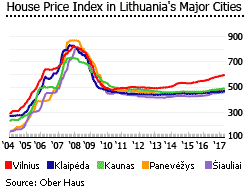
Before the global crisis, Lithuania saw enormous house price increases. The average price of old apartments in Central Vilnius rose 275% between 2002 and 2006:
- In 2003, house prices increased 28%
- In 2004, house prices increased 29%
- In 2005, house prices increased 45%
- In 2006, house prices increased 56%
Residential property prices in the capital started to decline in 2008, after the global credit crunch. The housing market has not yet fully recovered since then.
- In 2008, house prices fell by 15.23% (-21.85% inflation-adjusted)
- In 2009, house prices fell by 26.84% (-27.77% inflation-adjusted)
- In 2010, house prices fell by 2.98% (-6.55% inflation-adjusted)
- In 2011, house prices dropped by 0.64% (-3.91% inflation-adjusted)
- In 2012, house prices dropped by 1.65% (-4.36% inflation-adjusted)
In 2013, the property market finally recovered with house prices rising by 1.12 (0.76% inflation-adjusted) from a year earlier. House prices rose modestly by 3.34% (3.61% inflation-adjusted) in 2014 and by 2.29% (2.38% inflation-adjusted) in 2015. Last year, house prices rose strongly by 5.5% (3.72% inflation-adjusted).
Land prices are rising
In Vilnius, particularly in the city´s centre, land prices rose by around 10% to 15% in 2016, according to OberHaus.
- In the city centre, land prices for residential developments range from €400 to €1,500 per sq. m.
- In the capital’s residential districts, land prices range from €60 to €200 per sq. m.
- In the city suburbs, such as Visoriai, Riese, Bajorai, Kalnenai, and Gulbinai, land prices range from €20 to €80 per sq. m.
Construction activity back to its pre-crisis levels
During the 1980s, when the country was still socialist, more than 20,000 dwelling units were built annually.
Completions dropped to less than 5,000 annually between 1998 and 2003, leaving a huge, pent-up demand.
As the economy gathered steam, housing construction accelerated:
- In 2004-2006 dwellings completions rose to an average of 6,700 yearly
- In 2007, there were 9,286 completed dwellings
- In 2008 dwelling completions rose to 11,286, the highest since 1992
From 2005 to 2008, almost 16,000 dwellings were authorized annually - around three times the number of completions.
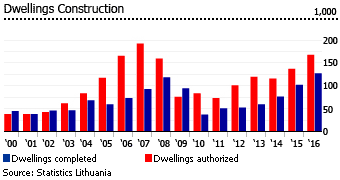
Then suddenly things stalled. In 2009, dwelling completions dropped to 9,400 units. Dwellings authorized fell from 19,229 units in 2007, to 7,553 in 2009. Completions averaged just 5,500 units annually from 2010 to 2014, and dwellings authorized also dropped to an annual average of just 9,800 units in 2010-14. Construction activity started to show real improvements in 2015 and last year, all indicators point that it is back to its pre-crisis levels.
In 2016:
- The number of dwellings for which building permits were granted surged 22.3% y-o-y to 16,765 units in 2016, based on figures from Statistics Lithuania.
- Dwelling completions soared 24.8% y-o-y to 12,703 units in 2016, the highest level ever.
Mortgage market continues to recover
Mortgage debt rose to 22.4% of GDP in 2009, from a mere 0.4% in 2000, with about 80% of all purchases made with the aid of mortgages, and typically 95% of property value granted in loans.

The mortgage market contracted during the crisis, reaching 16.45% of GDP in 2014. It showed real growth in 2015 and the recovery continued in 2016, with outstanding housing loans rising by 6.76% y-o-y and the market´s sizereaching 17.2% of GDP.
Almost 99% of the total loans have initial rate fixation of over 5 years.
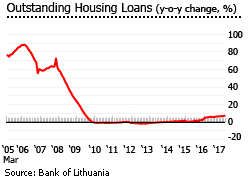
The amount of new housing loans in February 2017 amounted to €88.7 million, up by 10% from €80.6 million the previous year.
Interest rates remain low
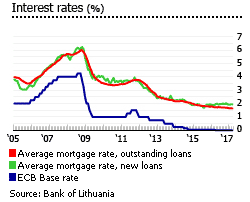
Interest rates on housing loans continued low with the adoption of the euro in January 2015.In February 2017, the average interest rate for new housing loans was 1.94%, slightly up from 1.89% a year earlier, according to the Bank of Lithuania.
In February 2002 the litashad been pegged to the euro at €1 = LTL3.4528. The rates on litas and euros converged, and from 2005 to mid-2007 there was not much difference between interest rates on new housing loans whether denominated in litas or in euro.Yet during the crisis the two currencies followed different paths.Interest rates on litas-denominated new housing loans surged to around 10% from April to October 2009, before falling to 6.2% in March 2010, while interest rates on euro-denominated housing loans simply followed the key ECB rate downward. As well as causing distress to borrowers, the litas rate hikes caused the market to shift to euro.
No less than 80% to 90% of new loansthe ratio became euro-denominated from 2009 to Q1 2010, and now all new loans are in euros.
In February 2017:
- The average interest rate for new housing loans with initial rate fixation (IRF) of up to 1 year stood at 1.79%, slightly up from 1.76% a year earlier.
- The average rate for new housing loans with IRF of more than 1 year was 3.04%, up from just 2.59% a year ago.
On the other hand, average interest rates for outstanding housing loans fell to 1.64% in February 2017, from 1.73% a year ago. Over the same period:
- The average rate for outstanding loans with IRF of up to 1 year stood at 1.08%, up from 0.62% a year earlier.
- The average rate for outstanding loans with IRF of 1-5 years was 2.77%, up from 2.12% a year ago.
- The average rate for outstanding loans with IRF of over 5 years was 1.63%, down from 1.73% a year earlier.
Rental yields remain good; rents continue to rise modestly
Rental yields in the capital city remain moderate to good.
- In the city centre, the average gross rental yield for one to two-bedroom apartments was 4.5% to 5% in 2016, according to OberHaus.
- In the residential districts, the average gross rental yield for one to two-bedroom apartments ranged from 5% to 6% in 2016.
From 2002 to 2007, the average rent for a one-bedroom apartment rose by a mere 18% while the average apartment sale price soared by 197% (from € 1,217 per sq. m. to €3,623). However, house prices started to plunge in 2009 due to the global crisis and reached their lowest levels in 2013. During the thatperiod, apartment rents continued to rise, resulting in increases in gross rental yields in the country’s major cities.
In 2016, apartment rents in all major Lithuanian cities rose between 2% and 5% from the previous year, according to OberHaus.
- In Vilnius, the average monthly rent for one to three-bedroom apartments stood at €379 per sq. m. in 2016
- In Kaunas, the average rent for the same apartment was €283 per month
- In Klaipėda, the average rent was €272 per month
- In Šiauliai, the average rent was €150 per month
- InPanevėžys, the average rent was €115 per month
Bigger houses in the city centre, the Old Town and other prestigious districts, such as Valakampiai, Antakalnis, and Zverynas, are offered for much higher rents, which vary from €850 to €2,200 per month in 2016.
Modest economic growth
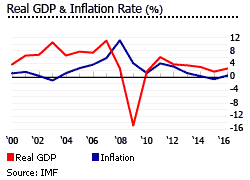
After average growth of 8.2% from 2001 to 2007 the economy began to slow in 2008, due to contagion from the global financial meltdown. In 2009, the Lithuanian economy shrank by almost 15%, the worst recession in the EU, largely due to the bursting of the property bubble, higher tax rates, the end of cheap money and a huge contraction in exports.
In 2010 the economy finally emerged from recession, with GDP growth of 1.6%.
Then in 2011 the Lithuanian economy began to expand strongly, with real GDP growth of 6.1%, the second fastest pace in the EU. In 2014, Lithuania’s economy expanded by a modest 2.9%, after expanding by 3.3% in 2013, and 3.8% in 2012, according to Statistics Lithuania. Lithuania’s growth over the past five years has been impressive. However in 2015, economic growth slowed to 1.6%, the slowest growth since 2009, due to sluggish investment and decline in exports to Russia, the country´s largest single trading partner.
Then in 2016, the economy expanded by 2.2%, amidst strong household consumption. The economy is expected to expand by a modest 2.9% this year and by another 2.8% in 2018, according to the European Commission.
Nationwide unemployment increased slightly to 8.3% in February 2017, from 8% in the same period last year, according to Eurostat.
Inflation accelerated to 3.2% in February 2017, up from just 0.7% in 2016 and a deflation of 0.7% in 2015, according to Eurostat.
Inflation is expected at 2.1% this year and 1.9% next year, according to the European Commission.
Lithuania’s public finances at sustainable levels
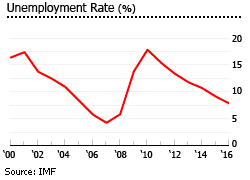
Lithuania’s budget deficit stood at 0.5% of GDP in 2016, from 0.2% in 2015, 0.7% in 2014 and 2.6% in 2013 and far below the 3% limit under the EU’s stability and growth pact.
During the global crisis, the deficit had ballooned to 9.4% of GDP in 2009, and remained high in 2010 at 7.2% of GDP, and 8.9% in 2011. Then in 2012, Lithuania adopted a budget that would narrow the public sector deficit to 3.1% of GDP, in a bid to join the eurozone.
The country’s deficit is projected to increase slightly to 0.7% of GDP this year, according to the European Commission.
Government debt was equivalent to 40.8% of GDP in 2016, from 42.7% of GDP in 2015 and 40.7% of GDP in 2014, and still well below the 60% threshold.
Gross public debt is expected to increase to 43.5% of GDP this year before falling to 39.6% of GDP in 2017.
Lithuania joined the Euro on January 1, 2015, the bloc’s 19th member. Lithuania was refused euro entry once before, in 2006, after it failed to meet the inflation criteria. The Litas, which had been pegged to the Euro for a decade, went out of circulation.